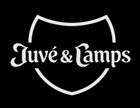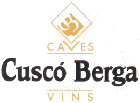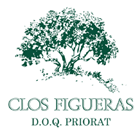Mestres
by
Kathy and Terry Sullivan
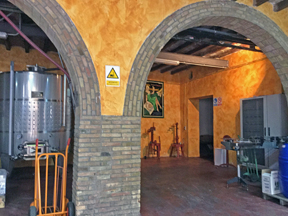 Summary: Mestres is located in Sant Sadurní d'Anoia and is one of the oldest families of the town producing cavas and wines. They have produced wine since the 1300s. The family was also one of the first to use the word “cava.”
Summary: Mestres is located in Sant Sadurní d'Anoia and is one of the oldest families of the town producing cavas and wines. They have produced wine since the 1300s. The family was also one of the first to use the word “cava.”
History
One of the older families from Sant Sadurní d’ Anoia is the Mestres family. The family has been growing grapes since 1312. It is believed that at that time, the family owned 100 hectares (247 acres) of land. Originally grapes were sold to wineries. The family may have made wine through the centuries, but according to our guide it was Josep Mestres who led the family into the future with the founding of the cava company in 1925.
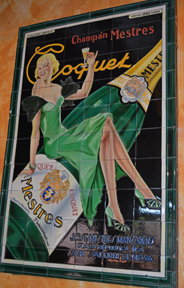 Three years later, the Mestres family celebrated their first commercial cava release. Josep was a bon vivant who enjoyed fine dining at the best restaurants. He loved good food and cava and wanted to craft cavas that would pair well with foods. The Mestres cava company became known for crafting cavas for specific chefs at different restaurants, a practice that occasionally continues today. A special cava is made for sommeliers to pair specifically with red tuna.
Three years later, the Mestres family celebrated their first commercial cava release. Josep was a bon vivant who enjoyed fine dining at the best restaurants. He loved good food and cava and wanted to craft cavas that would pair well with foods. The Mestres cava company became known for crafting cavas for specific chefs at different restaurants, a practice that occasionally continues today. A special cava is made for sommeliers to pair specifically with red tuna.
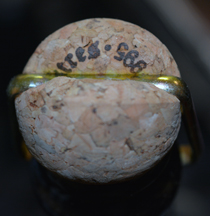 The cava producer has a number of firsts and unique protocols for cava production. Our guide noted that Mestres is the first producer to use the word “cava” and the first to make a brut nature. Half of Mestres’ cava portfolio is made from base wines that are aged in used chestnut barrels. Chestnut barrels do not impart the aromas and flavors associated with oak barrels. The special chestnut barrels are from the local region. For the secondary fermentation process, all bottles are corked rather than capped. This requires all bottles to be disgorged by hand rather than machine. At the time of disgorgement, the disgorger smells each cava bottle to notice any traces of cork taint. If found the cava is discarded.
The cava producer has a number of firsts and unique protocols for cava production. Our guide noted that Mestres is the first producer to use the word “cava” and the first to make a brut nature. Half of Mestres’ cava portfolio is made from base wines that are aged in used chestnut barrels. Chestnut barrels do not impart the aromas and flavors associated with oak barrels. The special chestnut barrels are from the local region. For the secondary fermentation process, all bottles are corked rather than capped. This requires all bottles to be disgorged by hand rather than machine. At the time of disgorgement, the disgorger smells each cava bottle to notice any traces of cork taint. If found the cava is discarded.
The winery uses 60 percent of the first press juice and sells the remaining juice, grapes and seeds. Their annual production is about 150,000 bottles of cava and 5,000 bottles of still wine.
Tour
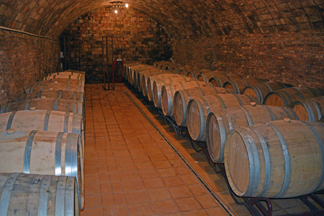 Our tour began at a ceramic tile poster from the 1920s. It shows a blond woman on a bottle of Coquet. One can note the word “champan” rather than the word “cava.” Back in the 1920s, sparkling wines were known as champagnes. The tour proceeded to the cellars where it appears that every possible space is filled with cava bottles aging on their sides. In one of these underground chambers, barrels age the base wines that will eventually become a blend for a cava. Most of the barrels contain Xarel.lo or Macabeo. There was an interesting story about one of the caves. It use to connect to city hall and occasionally the mayor would enter the caves for an attitude adjustment.
Our tour began at a ceramic tile poster from the 1920s. It shows a blond woman on a bottle of Coquet. One can note the word “champan” rather than the word “cava.” Back in the 1920s, sparkling wines were known as champagnes. The tour proceeded to the cellars where it appears that every possible space is filled with cava bottles aging on their sides. In one of these underground chambers, barrels age the base wines that will eventually become a blend for a cava. Most of the barrels contain Xarel.lo or Macabeo. There was an interesting story about one of the caves. It use to connect to city hall and occasionally the mayor would enter the caves for an attitude adjustment.
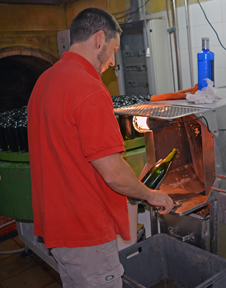 Our tour proceeded to the bottling room, where we saw cement riddling racks. The bottling room has a circular dish filled with upside down bottles. The neck of the bottles is in a solution that freezes the plug containing dead yeast cells and sediment. The bottles are taken, one at a time, and placed in the disgorgement cylinder.
Our tour proceeded to the bottling room, where we saw cement riddling racks. The bottling room has a circular dish filled with upside down bottles. The neck of the bottles is in a solution that freezes the plug containing dead yeast cells and sediment. The bottles are taken, one at a time, and placed in the disgorgement cylinder.
Using a special pair of pliers, made specifically for disgorging corks from cava bottles, a worker removed the metal clasp holding the cork in the bottle. Then he used the pliers to grab the cork and remove it. Some of the cava fizzed out of the bottle propelling the plug with it. The bottle was then placed on the bottling line where it would receive a zero dosage, cork, wire cage with chapa, foil capsule and label.
On the day of our visit, they were disgorging and corking a brut nature. There was no sugar dosage added to the cava. Rather the worker took the first bottle after disgorging and used the cava in that bottle for the dosage for the next several bottles. Only a little cava is needed to replace what was lost during disgorgement.
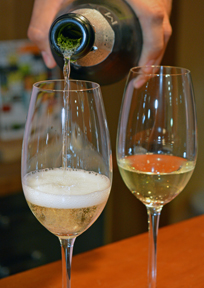 Tasting
Tasting
We tasted the 80th Anniversary Brut Gran Reserva 2008. This cava was produced with Macabeo, Xarel.lo and Parellada grape varieties. Seventy percent of the grapes were from their own vineyards that were 50 years old. The cava had five grams per liter of residual sugar. The light yellow cava had a column of tiny bubbles. The Macabeo and Xarel.lo base wines were aged in chestnut barrels. The cava offered aromas of floral and baked apple. The taste was of baked apples, mineral and some spices. The finish had notes of apple and citrus.
The 2007 Visol Brut Nature Gran Reserva was a blend of 35% Macabeo, 40% Xarel.lo and 25% Parellada. The cava was yellow colored with small bubbles rising to form a small mousse on the surface. The aroma and taste were floral and had white peach notes.There was chalk and white peach on the finish with freshly baked bread on the aftertaste.
The 2009 Coquet Brut Nature Gran Reserva was blended with 30% Macabeo, 45% Xarel.lo and 25% Parellada. This light yellow colored cava had a column of beads forming a mousse on the surface. The aroma and taste offered green apple and minerality with a lively mouthfeel. The finish had apple, citrus and chalk.
The non-vintage 1312 Reserva was a blend of 30% Macabeo, 30% Xarel.lo and 40% Parellada. A light yellow color, this cava had multiple bubble beads forming a surface mousse. The aroma and taste were predominantly apple with a nice mouthfeel.The finish was of apple with a hint of minerality.
Wine Tourism
A tour of the caves and bottling area and a wine tasting are available. Interested wine enthusiasts should make an appointment by calling the winery or use the winery website to contact the winery.
Mestres
Plaça Ajuntament, 8
Sant Sadurní d’ Anoia
08770 Barcelona, Spain
Article written June 2015
Please support the following.
 |
|||
 |
 |
